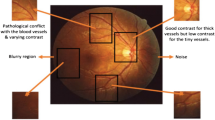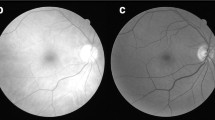Abstract
The main purpose of identifying and locating the retina vessels is to specify from the fundus image the various tissues of the vascular structure, which can be wide or tight. The classification of vessels in the retinal image often confronts several challenges, such as the low contrast accompanying the fundus image, the inhomogeneity of the background lighting, and the noise. Moreover, fuzzy c-means (FCM) is one of the most frequently used algorithms for medical image segmentation due to its effectiveness. Hence, many FCM method derivatives have been developed to improve their noise robustness and time-consuming. This paper aims to analyze the performance of some improved FCM algorithms to recommend the best ones for the segmentation of retinal blood vessels. Eight derivatives of FCM algorithm are detained in this study: FCM, EnFCM, SFCM, FGFCM, FRFCM, DSFCM_N, FCM_SICM and SSFCA. The performance analysis is conducted from three viewpoints: noise robustness, blood vessels segmentation performance, and time-consuming. At first, the noise robustness of improved FCM clustering algorithms is evaluated using a synthetic image degraded by various types and levels of noise. Then, the ability of the selected algorithms to segment retinal blood vessels is assessed based on images from the DRIVE and STARE databases after a pre-processing phase. Finally, the time consumption of each algorithm is measured. The experiments demonstrate that the FRFCM and DSFCM_N algorithms achieve better results in terms of noise robustness and blood vessels segmentation. Regarding the running time, the FRFCM algorithm requires less time than other algorithms in the segmentation of retinal images. The results of this study are extensively discussed, and some suggestions are proposed at the end of this paper.







Similar content being viewed by others
Data Availability
Enquiries about data availability should be directed to the authors.
Notes
References
Abdulsahib AA, Mahmoud MA, Mohammed MA, Rasheed HH, Mostafa SA, Maashi MS (2021) Comprehensive review of retinal blood vessel segmentation and classification techniques: intelligent solutions for green computing in medical images, current challenges, open issues, and knowledge gaps in fundus medical images. Netw Model Anal Health Inf Bioinf 10(1):1–32
Ahmed MN, Yamany SM, Mohamed N, Farag AA, Moriarty T (2002) A modified fuzzy c-means algorithm for bias field estimation and segmentation of mri data. IEEE Trans Med Imaging 21(3):193–199
Almotiri J, Elleithy K, Elleithy A (2018) Retinal vessels segmentation techniques and algorithms: a survey. Appl Sci 8(2):155. https://doi.org/10.3390/app8020155
Azzopardi G, Strisciuglio N, Vento M, Petkov N (2015) Trainable cosfire filters for vessel delineation with application to retinal images. Med Image Anal 19(1):46–57. https://doi.org/10.1016/j.media.2014.08.002
Bezdek JC, Ehrlich R, Full W (1984) Fcm: The fuzzy c-means clustering algorithm. Comput Geosc 10(2–3):191–203
Bhabatosh C et al (1977) Digital image processing and analysis. PHI Learning Pvt Ltd, UK
Cai W, Chen S, Zhang D (2007) Fast and robust fuzzy c-means clustering algorithms incorporating local information for image segmentation. Pattern Recogn 40(3):825–838
Chaira T (2022) Neutrosophic set based clustering approach for segmenting abnormal regions in mammogram images. Soft Computing 26(19):1–11
Chuang KS, Tzeng HL, Chen S, Wu J, Chen TJ (2006) Fuzzy c-means clustering with spatial information for image segmentation. Comput Med Imag Graph 30(1):9–15
Comaniciu D, Meer P (2002) Mean shift: A robust approach toward feature space analysis. IEEE Trans Pattern Anal Mach Intell 24(5):603–619
Dunn JC (1973) A fuzzy relative of the isodata process and its use in detecting compact well-separated clusters. J Cyber 3(3):32–57. https://doi.org/10.1080/01969727308546046
Fraz MM, Remagnino P, Hoppe A, Uyyanonvara B, Rudnicka AR, Owen CG, Barman SA (2012) An ensemble classification-based approach applied to retinal blood vessel segmentation. IEEE Trans Biomed Eng 59(9):2538–2548. https://doi.org/10.1109/TBME.2012.2205687
Gonzalez RC, Woods RE, et al. (2002) Digital image processing
Hoover AD, Kouznetsova V, Goldbaum M (2000) Locating blood vessels in retinal images by piecewise threshold probing of a matched filter response. IEEE Trans Med Imaging 19(3):203–210. https://doi.org/10.1109/42.845178
Huang J, Nie F, Huang H (2015) A new simplex sparse learning model to measure data similarity for clustering. In: Twenty-fourth international joint conference on artificial intelligence
Imran A, Li J, Pei Y, Yang JJ, Wang Q (2019) Comparative analysis of vessel segmentation techniques in retinal images. IEEE Access 7:114862–114887
Jia X, Lei T, Du X, Liu S, Meng H, Nandi AK (2020) Robust self-sparse fuzzy clustering for image segmentation. IEEE Access 8:146182–146195
Lei T, Jia X, Zhang Y, He L, Meng H, Nandi AK (2018) Significantly fast and robust fuzzy c-means clustering algorithm based on morphological reconstruction and membership filtering. IEEE Trans Fuzzy Syst 26(5):3027–3041
Li BN, Chui CK, Chang S, Ong SH (2011) Integrating spatial fuzzy clustering with level set methods for automated medical image segmentation. Comput Biol Med 41(1):1–10
Macqueen J (1967) Some methods for classification and analysis of multivariate observations. In: In 5-th Berkeley symposium on mathematical statistics and probability, pp 281–297
Nageswara Reddy P, Satyanarayana C, Mohan Rao C (2022) Brain tumour segmentation using hybrid approach. In: Machine learning and internet of things for societal issues, Springer, pp 117–125
Niemeijer M, Staal J, van Ginneken B, Loog M, Abramoff MD (2004) Comparative study of retinal vessel segmentation methods on a new publicly available database. In: Medical imaging 2004: image processing, international society for optics and photonics, vol 5370, pp 648–656, https://doi.org/10.1117/12.535349
Pizer SM, Amburn EP, Austin JD, Cromartie R, Geselowitz A, Greer T, ter Haar Romeny B, Zimmerman JB, Zuiderveld K (1987) Adaptive histogram equalization and its variations. Comput Vision, Graphics, Image Process 39(3):355–368. https://doi.org/10.1016/s0734-189x(87)80156-1
Porwal P, Pachade S, Kamble R, Kokare M, Deshmukh G, Sahasrabuddhe V, Meriaudeau F (2018) Indian diabetic retinopathy image dataset (idrid). IEEE Dataport, 3(3): 25 https://doi.org/10.21227/H25W98
Qiao C, Wu C, Wang J, et al. (2022) Robust fuzzy clustering algorithms integrating membership guided image filtering. Signal, Image and Video Processing pp 1–9
Shen Y, Tang C, Xu M, Lei Z (2021) Optical selective encryption based on the FRFCM algorithm and face biometric for the medical image. Optics & Laser Technol 138:106911
Singh M, Asha C, Sharma N (2022) Multi-objective particle swarm optimization based enhanced fuzzy c-means algorithm for the segmentation of MRI data. In: Recent trends in electronics and communication, Springer, pp 1031–1041
Song Y, Li M, Zhu Z, Yang G, Luo X (2022) Non-negative latent factor analysis-incorporated and feature-weighted fuzzy double c-means clustering for incomplete data. IEEE Trans Fuzzy Syst. https://doi.org/10.1109/TFUZZ.2022.3144489
Srinidhi CL, Aparna P, Rajan J (2017) Recent advancements in retinal vessel segmentation. J Med Syst 41(4):70. https://doi.org/10.1007/s10916-017-0719-2
Staal J, Abràmoff MD, Niemeijer M, Viergever MA, Van Ginneken B (2004) Ridge-based vessel segmentation in color images of the retina. IEEE Trans Med Imaging 23(4):501–509. https://doi.org/10.1109/tmi.2004.825627
Szilagyi L, Benyo Z, Szilágyi SM, Adam H (2003) Mr brain image segmentation using an enhanced fuzzy c-means algorithm. In: Proceedings of the 25th annual international conference of the IEEE engineering in medicine and biology society (IEEE Cat. No. 03CH37439), IEEE, vol 1, pp 724–726
Wang Q, Wang X, Fang C, Yang W (2020) Robust fuzzy c-means clustering algorithm with adaptive spatial & intensity constraint and membership linking for noise image segmentation. Appl Soft Comput 92:106318
Xue J, Nie F, Wang R, Li X (2022) Iteratively re-weighted algorithm for fuzzy c-means. IEEE Trans Fuzzy Syst. https://doi.org/10.1109/TFUZZ.2022.3148823
Zadeh L (1965) Fuzzy sets. Inf Control 8(3):338–353. https://doi.org/10.1016/S0019-9958(65)90241-X
Zhang H, Li H, Chen N, Chen S, Liu J (2022) Novel fuzzy clustering algorithm with variable multi-pixel fitting spatial information for image segmentation. Pattern Recogn 121:108201
Zhang Y, Bai X, Fan R, Wang Z (2018) Deviation-sparse fuzzy c-means with neighbor information constraint. IEEE Trans Fuzzy Syst 27(1):185–199
Zuiderveld K (1994) Contrast limited adaptive histogram equalization. Graphics Gems pp 474–485
Funding
There is no funding for this study.
Author information
Authors and Affiliations
Corresponding author
Ethics declarations
Conflict of interest
The authors declare that they have no conflict of interest.
Ethical approval
This article does not contain any studies with human participants or animals performed by any of the authors.
Informed consent
Informed consent was obtained from all individual participants included in the original study.
Additional information
Communicated by Hemen Dutta.
Publisher's Note
Springer Nature remains neutral with regard to jurisdictional claims in published maps and institutional affiliations.
Rights and permissions
Springer Nature or its licensor holds exclusive rights to this article under a publishing agreement with the author(s) or other rightsholder(s); author self-archiving of the accepted manuscript version of this article is solely governed by the terms of such publishing agreement and applicable law.
About this article
Cite this article
Mehidi, I., Belkhiat, D.E.C. & Jabri, D. Comparative analysis of improved FCM algorithms for the segmentation of retinal blood vessels. Soft Comput 27, 2109–2123 (2023). https://doi.org/10.1007/s00500-022-07531-9
Accepted:
Published:
Issue Date:
DOI: https://doi.org/10.1007/s00500-022-07531-9




